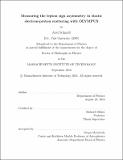| dc.contributor.advisor | Richard Milner. | en_US |
| dc.contributor.author | Schmidt, Axel (Axel William) | en_US |
| dc.contributor.other | Massachusetts Institute of Technology. Department of Physics. | en_US |
| dc.date.accessioned | 2017-02-22T19:00:42Z | |
| dc.date.available | 2017-02-22T19:00:42Z | |
| dc.date.copyright | 2016 | en_US |
| dc.date.issued | 2016 | en_US |
| dc.identifier.uri | http://hdl.handle.net/1721.1/107040 | |
| dc.description | Thesis: Ph. D., Massachusetts Institute of Technology, Department of Physics, 2016. | en_US |
| dc.description | Cataloged from PDF version of thesis. | en_US |
| dc.description | Includes bibliographical references (pages 265-273). | en_US |
| dc.description.abstract | OLYMPUS is a particle physics experiment that collected data in 2012 at DESY, in Hamburg, Germany, on the asymmetry between positron-proton and electron-proton elastic scattering cross sections. A non-zero asymmetry is evidence of hard two-photon exchange, which has been hypothesized to cause the discrepancy in measurements of the proton's electromagnetic form factors. Alternating electron and positron beams, accelerated to 2 GeV, were directed through a windowless, gaseous, hydrogen target, and the scattered lepton and recoiling proton were detected in coincidence using a large acceptance magnetic spectrometer. Determining the relative integrated luminosity between the electron and positron data sets was critical, and a new technique, involving multi-interaction events, was developed to achieve the desired sub-percent accuracy. A detailed Monte Carlo simulation was built in order to reproduce the convolution of systematic effects at every stage of the experiment. The first stage in the simulation was new radiative event generator, which permitted the full simulation of the non-trivial radiative corrections to the measurement. The analysis of the data and simulation showed that the lepton sign asymmetry rises by several percent between a momentum transfer of 0.5 GeV2 /c2 and 2.25 GeV2 /c2 . This rise as a function of increasing momentum transfer confirms that two photon exchange at least partially contributes to the proton form factor discrepancy. | en_US |
| dc.description.statementofresponsibility | by Axel Schmidt. | en_US |
| dc.format.extent | 273 pages | en_US |
| dc.language.iso | eng | en_US |
| dc.publisher | Massachusetts Institute of Technology | en_US |
| dc.rights | MIT theses are protected by copyright. They may be viewed, downloaded, or printed from this source but further reproduction or distribution in any format is prohibited without written permission. | en_US |
| dc.rights.uri | http://dspace.mit.edu/handle/1721.1/7582 | en_US |
| dc.subject | Physics. | en_US |
| dc.title | Measuring the lepton sign asymmetry in elastic electron-proton scattering with OLYMPUS | en_US |
| dc.type | Thesis | en_US |
| dc.description.degree | Ph. D. | en_US |
| dc.contributor.department | Massachusetts Institute of Technology. Department of Physics | |
| dc.identifier.oclc | 970697186 | en_US |
